Since the keyword “gamification” cropped up around 20 years ago, the phenomenon has spread rapidly. Together with the gaming culture, playing has become the focus of our digital society, also in the advertising and marketing sector. Games are not only thriving in the digital section, but also in the analogue area. Whereby gamification means more than a board or card game individualised with a logo. It actually involves a communicative process at the core of the game, which among others also satisfies the need for haptic experiences, as many examples demonstrate.
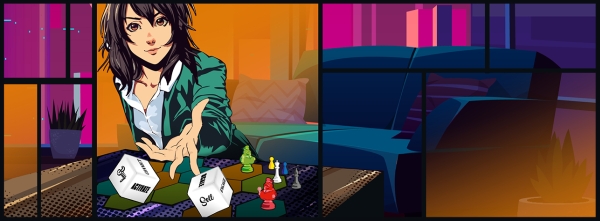
It was there all of a sudden: The possibility to steal real pieces of art. Whereby the eight original works of art were painted by the artists precisely for this purpose. They were material for an elaborate art theft game that Netflix used to advertise the action film Red Notice in Germany. Whereby in India, Netflix built a shop, where objects secured by alarm, including three golden Fabergé eggs, were exhibited. Whoever was able to steal them without getting caught was able to keep them as the prize. In this way, the worldwide marketing campaign for Red Notice created gaming worlds in the year 2021 that allowed the participants to slip into the role of art thieves.
Such upscaled games can activate the target group in a cross-media way, but the real, haptically tangible pieces of art with their presence in the physical world add the final touch. Gamification at its best.
The seriousness of gaming
When people talk about gamification and its possibilities, they are normally referring to digital applications. However, Christoph Deeg, Consultant for Transformative Gamification, points out: “It is about processes, not software.” Generally, gamification is defined as the use of game elements in non-game contexts. So this doesn’t have to be limited down to digital media and channels at all.

Netflix advertised the film Red Notice with an art theft game that included paintings.
Activating people using games or playful means is a very old principle. The invention of Monopoly was already based on the idea of gamification – whereby the term didn’t exist yet at the time. When Lizzie Magie developed the game she called The Landlord’s Game in 1903, it aimed to illustrate the consequences of land speculation. And Johann Hellwig used the War Game to teach his pupils at the Military Academy in Braunschweig the basic principles of strategy and tactics in 1780 already. These are just two examples of games that strove to help people understand complex processes like the economy and war better. In the meantime, learning and planning games have evolved into the special genre of so-called “serious games”.
“Games are immensely efficient at conveying so-called systems knowledge. It is about the analysis of procedures and processes, dependencies and correlations and consequences,” the game design, Till Meyer, explained, who for instance co-developed the blackout simulation Neustart for the Austrian Society for Crisis Precaution. The game is implemented for training courses as well as for PR purposes.
Gamified marketing
Games work for both inter-organisational educational measures as well as for external communications because gaming activates, conveys knowledge and generates positive feelings. With the help of these connecting factors gamification pursues three aims in the marketing and advertising sector: The customer/user engagement, i.e. activation through the game (means), inciting purchase transactions (purpose), the generation of “brand awareness”, i.e. conveyance of knowledge about a brand, product or service and the creation of “brand loyalty”, i.e. a permanent conviction that leads to repeated purchases or orders.
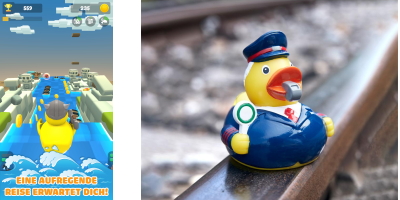
Rubberduck’s Journey interlinks the haptic item with the digital game.
Philipp Reinartz, founder and Managing Director of the gamification agency, Pfeffermind, describes the major difference to conventional marketing methods: “The interaction is fun and when one takes an active part in something that is fun, one remembers the contents more readily. Our customers tell us the points they want us to convey and then we consider how these can be integrated into a game.”
Games are ideal for mobilising the target group and for turning having to do something into wanting to do something. Roman Rackwitz, Gamification Designer and founder of the agency, Engaginglab, knows why: “People seek challenges in games, hobbies, sports – areas that consist of mastering voluntary obstacles.” Playful challenges trigger off an intrinsic motivation, which activates people and accomplishing the challenges conveys the experience of self-efficacy.
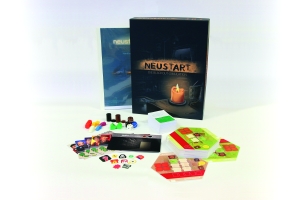
The Austrian Society for Crisis Precaution’s blackout simulation Neustart is also implemented by the Austrian Armed Forces.
New approaches for brand storytelling arise through the game design – i.e. determination of the rules, processes, options for action, probabilities, etc. “It involves telling a story about what defines the brand,” the game designer, Markus Utomo, stated, who among others has developed board games for the German airline, Lufthansa. The special thing about gaming is that the players are actively involved in this storytelling and don’t merely take in the story passively.
However, a whole game doesn’t always have to be developed. Using individual elements that trigger off the play instinct often suffices. McDonald‘s has been repeatedly successful with its popular Monopoly campaign since 1987. One receives a sticker with a random street in a certain colour for every purchase of a McDonald’s product, sets in matching colours can then be exchanged for prizes. This concept picks up on the well-known set collection mechanism of Monopoly and turns it into a marketing tool without an entire game having to be reproduced.
Collecting and raffling are two of the oldest game mechanisms used in marketing. Airlines like United Airlines have been using game elements since the 1970s for their loyalty programmes. Similar premium programmes are in the meantime standard in the retail trade. For a long time the activation of levels and achievements that are often involved were falsely put on a par with gamification. Whereby in the case of such approaches, one attempts to generate motivation extrinsically by awarding prizes as a reward, rather than using dedicated interaction as an incentive. No special challenge has to be mastered – one merely additionally receives points for making a purchase, that one would make anyway.
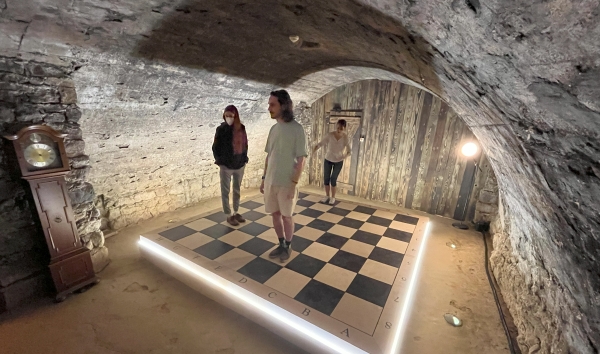
The mattress company, Casper’s OOH campaign in the New York subway in 2019 on the other hand relied on intrinsic motivation. A rebus puzzle without any other context was printed on each of the advertising posters, which the passengers could solve – the company published the solutions on its website. Casper subsequently published the puzzles as a colouring book.
Such activity books, but also puzzles and games, make popular promotional products. Suppliers like the Belgian Cartamundi Group provide the international market with individually designed playing cards and board games, whereas for example Winning Moves offers licenses for well-known board games like Monopoly and Cluedo, the themes and design of which can be adapted by the user, who chooses to implement these games for advertising purposes or as merchandising. There are also specialised suppliers on the national markets, who implement individualised games.
Gaming as a multisensory experience
The sales trainer, Virgil Schmid, demands: “Tempt people to play games instead of a blatant persuasion to buy; fun instead of boredom; entertaining surprise instead of a predictable glossy world.” Playful marketing strategies can help stop advertising being perceived as a negative nuisance that forces one to pay attention, acting instead as a pleasant invitation to occupy oneself more intensively with a product or brand at different levels. “Companies that invite their customers to play can create holistic experiences that not only call upon their customers to hear and see, but which actually involve all of the senses,” explained Schmid.
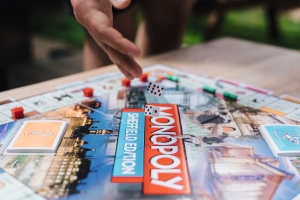
Haptic advertising offers an outstanding starting point to devise such a multisensory experience with analogue or hybrid game ideas. Reinartz points out: “Analogue games have a haptic quality as a result of the spectrum of different materials that can be implemented.” For example Pfeffermind developed a print-and-play game on cybersecurity for Bosch that is designed so that it can be printed out all over the world and played using common office materials.
Venue and community of the players
According to the gamification expert, Reinartz, analogue games are especially good for creating common ground, i.e. for team events or when they are linked with a specific location, like museums for instance. For haptic marketing this means the customers of a brand can unite the players via gamified campaigns within the community and that analogue gamification approaches are ideal for shops, trade fairs, events and promotion campaigns in public spaces because they live from their presence.
For example, the German children’s aid organisation, Kinderarche Sachsen, implemented a self-developed, cooperative board game for its 30th anniversary celebrations that served as the common theme of the programme and was used to playfully involve the audience, which also included politicians and supporters. The game that promoted a community spirit through the joint activity was implemented as a merchandising item and donation premium after the event and communicates the values of the organisation as a physical product.
Haptics with digital technology
The Managing Director of Pfeffermind, Reinartz, claims that games with haptic elements are attractive, because people don’t want to just sit in front of the screens: “Escape Rooms, for example, come from the digital point-and-click adventures sector, which were then transferred into the real world, where they are very successful. People want something tangible.”
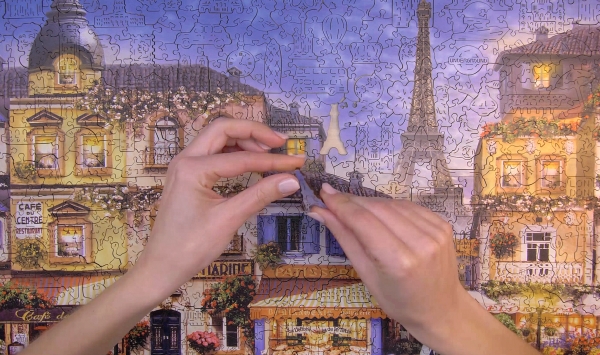
Puzzles are among the most popular games on the promotional products market.
This need for a haptic experience can also apply, when the actual game is digital, as Othmar Fetz, Managing Director of the software company, dMas, determined. His company develops digital gaming consoles for exhibition stands under the label Gamify. Here the multisensory effect enfolds through the physical presence and the haptic quality of the lever and buttons: “Everyone wants to hit a big, red buzzer. Objects have a stimulative character, there’s a psychological attraction to touch things.”
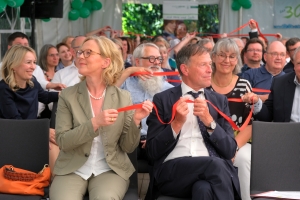
Playing games together unites. Here at the anniversary celebrations of the children’s aid organisation, Kinderarche Sachsen.
In the scope of its “Fun Theory”, Volkswagen Sweden already relied on the connection between physical space and modern technology in 2009. In one of the probably most famous examples of gamification the steps of a stairway were converted into piano keys that played notes when stepped on. The aim was to playfully encourage people to use the stairs. VW Sweden realised a similar concept with a sound device in a dustbin, which triggered off sounds when rubbish was thrown inside, motivating people to let less waste fall to the ground.
For some of the Escape games Pfeffermind has developed for its customers, the gamification agency has also combined the physical presence of analogue game playing with the possibilities that modern, digital technology provides. In this way, Philipp Reinartz’s team built sensors into a huge chess board at Mildenstein Castle, a tourist attraction in East Germany, which reacted to the movements of the visitors. RFID chips inside objects allow the recognition of their related position to each other, when playing around with them, so for instance one has to move them into a certain order to solve a puzzle. AR tools can also be linked to the virtual and material world.
For example, Pringles developed an AR game, that could be activated via a QR code on the product packaging in the scope of a cross-media campaign for the 2022 World Football Championships. The digital game, where collectable characters had to be activated that could subsequently be won as physical objects, was accessed via the physical Pringles packaging. Andreas Billker, Senior Market Activation Manager Pringles DACH, explained this interlinking between digital and analogue aspects: “We use the AR game to extend the consumers’ product experience. We initiated a collecting mechanism with the characters that we offered as a prize by AR you ready? At one time we had considered turning them into NFTs, but we rejected that idea relatively quickly. AR campaigns need a haptic aspect so that they work. In the case of AR you ready? it was our product, but it could just as easily be a promotional product. The promotional product would then so to speak be the entrance ticket for the digital experience.”
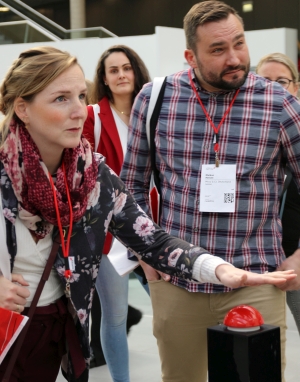
The Gamify buzzer emphasises the haptic feel of digital control devices and attracts players to the exhibition stand.
The rubber duck in a conductor’s uniform that the Deutsche Bahn implemented for Rubberduck’s Journey is an example of such an admission ticket with an extended product experience. Here, one starts a browser game via the QR code printed on the duck and the branded, haptic toy comes to life digitally. Cyber-wear won at the Promotional Gift Award 2023 with this project that was jointly developed together with the duck supplier, mbw.
Prospects for haptic advertising
Many creative minds are working on extending the possibilities of analogue and hybrid gamification approaches. The potential is by no means exploited, especially when one considers what options arise when one succeeds in integrating haptic advertising into playful marketing campaigns. This ranges from classic ballpoint pens that are used to note down crossword clues, draw maps or solve codes, to board games that tell a brand’s story, through to special designs made of haptic game material.
It doesn’t have to have the same dimensions of the Red Notice campaign. Gamification can also support the branding of a company or an organisation on a smaller scale through the materiality of the game components – especially when they are promotional products that can be taken home, where they keep the memory of a multisensory experience alive.
// Andreas J. Haller
Photos: Cartamundi (1), Cyber-wear (2), Kinderarche Sachsen (1), Netflix (2), Pfeffermind (1), WA Media (2), Wooden City (1), Illustration: Jens C. Friedrich, WA Media; Shutterstock.com





